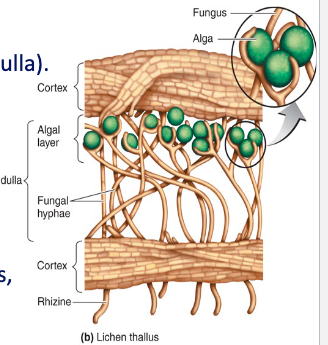Microbiology Chapter 12: Fungi, Algae, Protozoans, and Helminths
Fungi, Protozoa, and helminths can cause infectious disease in humans
Algae is not infectious but produce toxins
Anthropods can be vectors of transmission
Myco - usually means fungus of some type
Fungi
Features:
Chemoheterotrophic
Decompose organic matter
Plants depend on symbiotic fungi
Food source and drug source
Compared to bacteria, fungi:
Grow in acidic environments
more resistant to osmotic pressure
can grow in low moisture content
Molds and Fleshy Fungi
the body (thallus) possess cells in filaments → hyphae (can be septate or coenocytic)
Septate - small compartments that’s basically a cell
Coenocytic - No compartments; the nuclei basically float around
Vegetative (submerged) hyphae: nutrient uptake, metabolism, & growth
Aerial (above the mass of fungus) hyphae - for reproduction → spores
Mycelium - usually made up of the vegetative hyphae
Life Cycle
reproduction of fungi
Asexual →
Fragmen of hyphae
Asexual spores →
Conidiophore - not enclosed in a sac
sporangiophore - enclosed in a sac
Sexual →
Gamete formation →
sexual spores
Yeasts
yeast - non-filamentous, unicellular fungi
reproduce by budding yeasts & binary fission yeasts
Facultative anaerobes
Dimorphic fungi: two forms of growth
Di = two, morphic = shape
grows as mold or yeast; depends on temp (25ºC: mold like, 37ºC yeast like)
feature of many pathogenic fungi
Fungal disease → mycosis →
systemic - throughout the body
cutaneous - shallow part of the skin (EX: athlete’s foot)
subcutaneous - deeper or underneath the skin
Cutaneous or subcutaneous are called dermatophytes because they feed on skin or dead skin cells (DERMA)
Lichens
Fairly harmless and don’t cause disease in humans
Lichens - fungi that have a mutualistic relationship with algae or cyanobacteria
Diverse with more than 13,000 species
Often the first life forms to inhabit newly exposed soil or rock. Also found on trees, concrete structures, roof tops.
Think a fungi mixed with algae or cyanobacteria
Growth: lichen thallus (body) grows as fungal hyphae grow around the algal cells (forms the medulla)
Rhizines - hyphal projections below the body; anchors the lichen
Cortex - protective covering of hyphae
Fungus receives carbohydrates from alga; algae receives attachment and protection

Lichens can be indicators of air quality, food source for animals, and some produce antimicrobials.
Algae
It is not algae themselves that can harm of cause sickness to humans. It’s the toxins they produce
Eukaryotic photoautotrophs lacking plant tissues
Reproduce asexually/sexually
Multicellular: brown (kelp) & red algae, green algae
Unicellular (plankton): dinoflagellates; diatoms → these ones are the problems
Eutrophication causes a burst of these dinoflagellates creating a red tide
Agal disease - not infectious, disease ingestion of toxins
Dinoflagellates create a saxitoxin that’s eaten by and concentrated in sea life. When we eat these sea life, it causes harm through that build up of toxins
Neurotoxin - red tide from eutrophication → saxitoxin
Ciguatera - foodborne illness; in fish containing toxin
Diatoms - domoic acid toxicosis
Protozoa
Protozoa - unicellular eukaryotes, mostly aerobic heterotrophs
some anaerobic types, a few photosynthetic
Characteristics:
Motility via:
Flagella/flagellum
Cillia
undulating membrane
Pseudopods
Nutritional structures:
Digestion in vacuoles
Ciliates: intake of food via cytosomes
Amoeba: pseudopodia
reproduce asexually → fission/budding/schizogony (nuclei divide in cell)
Schizogony - cell full of nuclei where the nuclei divide
reproduce sexually → via conjugation/via union of gametes
not transferring plasmids but gametes
Some produce cysts under adverse conditions (encystment)
cysts are kind of the more dormant and resistant form in the environment that humans will then ingest
Cyst formation (Not mentioned much in the lecture but I don’t know if it’ll be on the test)
When the protozoan feels the environment become unfavorable (temp, ph, etc), it enters the process of encystation → protozoan secretes a thick, protective wall around itself, creating a cyst. → inside the cyst, the protozoan stops or slows down its metabolism in order to allow it to stay in the cyst for long periods of time
When the environment becomes favorable, the protozoan goes through excystation → cysts break open, allowing the protozoan to go on as normal
ASK TUTOR ABOUT THIS PART:
Apicomplexa - protozoan group possessing complex life cycles
Are obligate intracellular parasites → parasites that need to reproduce and live in the host in order to survive.
Contain a number of pathogens → plasmodium spp (malaria)
Malaria process:
Anopheles mosquito - carries sporozoite form (infective) in saliva
Sporozoites → form multiple merozoites (progeny) via schizogony in liver cells
Merozoites → infect red blood cell; become trophozoites (feeding stage)
Some merozoites develop into gametocytes; picked up by Anopheles bite
Terms part of the life cycle
Schizogony - mitosis to form numerous merozoites
Gamogony - mitosis and maturation of gametes
Sporogony - mitosis to form sporozoites within mosquito cells
Helminths
Multicellular eukaryotic animals
Specialized to live in hosts
May lack digestive system
reduced nervous system
reduced or lacking locomotion
complex reproductive system: can have complex life cycle; multiple hosts to complete each larval stage
Parasitic worms →
Platyhelminthes (flatworms) →
Trematodes (flukes)
Cestodes (tapeworm)
Nematodes (roundworms)
Trematodes
Flat, leaf-shaped; have ventral and oral sucker
absorb food through cuticle covering
Both vertebrate & mollusk host in life cycle
named for host tissue in which adult form lives
Paragonimus spp. - lung fluke, Schistosoma - blood fluke
Tapeworm
Scolex - head that has suckers for attachment
absorb food through skin (cuticle)
Proglottids - body segments making up the tapeworm
As it grows, it adds these proglottids and grows longer
contain male and female reproductive organs
Platyhelminth pathogens
Schistosomiasis (blood fluke, Schistosoma)
Lung fluke (Paragonimus spp): contaminated shellfish
Tapeworms (Taenia spp): eggs are generally ingested through food, water, or soil contaminated with human or animal (host) feces
Nematodes
Roundworms
Cylindrical; complete digestive system
Dioecious; males contain spicules
Free living and parasitic
Nematode pathogens
Eggs infective - Ascaris; pinworm (Enterobius); whipworm (Trichuris) → found in intestines of human hosts
Larva infective:
hookworm (Necator) - intestinal parasite
Trichinellosis - undercooked meat of infected animal
Heartworm (dirofilaria)